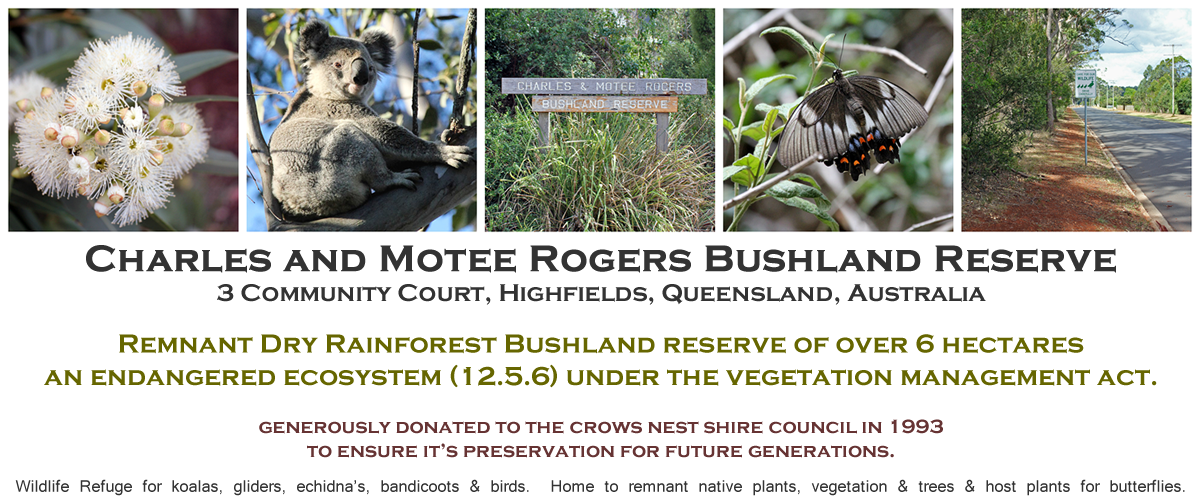An environmental weed working bee was performed today at the Charles and Motee Rogers Bushland Reserve at Highfields by 10 members of the Friends of Rogers Reserve group.
Weed identification training and the correct removal processes were taught by Greg Lukes from Friends of the Escarpment Parks Toowoomba and Trish Gardner from Friends of Franke Scrub.
While the Charles and Motee Rogers Bushland Reserve has a relatively low weed content, some common environmental weeds were identified and removed from the front perimeter and walking track edges of the bushland reserve. Greg recommended using a plastic bin or a large bucket to collect weeds and seeds for disposal instead of bags, which tend to disturb and possibly spread seeds in the bush.
While identifying and removing some weeds in the reserve today, many small native plant species were also identified emerging from the forest floor. Discussion was made about the purchase of tree bags and stakes to protect some of these small native species which are growing close to the footpath areas.
Some of the weeds removed today included Pavonia, Moth Vine, Ground Asparagus, Cobblers Pegs and Paspalum grass.
The Friends of Rogers Reserve Group will meet again at the Charles and Motee Rogers Bushland Reserve entrance on Community court at 9.00am, on Friday the 20th June. To have your name added to an email send-out please send us an email at rogersreserve {at} yahoo {dot} com {dot} au
(remove spaces and change bracketed words to punctuation symbols).
Thank you to everyone who attended today and to Greg and Trish for sharing their wealth of experience and knowledge with the group.
 |
| Environmental Weed ~ Pavonia (Pavonia hastata) is a woody herb that grows to 1.5m tall. The Pavonia flowers in Summer and is a pink hibiscus like flower 2.4cm across. Ongoing management and correct removal is vital as seeds have long viability n the soil. |
 |
| Pavonia (Pavonia hastata) leaves are distinctively arrow to oval shape. |
Large Pavonia Weed before it was removed
 |
| Greg removing the large Pavonia with his well designed weed removal shovel. |
 |
| Kathleen digging out a large Pavonia |
 |
| Trish explaining the need of wearing gloves to protect one's skin, when removing the Environmental Weed ~White Moth Vine (Araujia sericifera) due to the white sap that emerges from the weed when it is damaged. Moth Fine is also known as "False Choko", it flowers in summer with the distinctively choko shaped fruit in Autumn. The white moth vine smothers native plants. |
 |
| Trish explains the importance of removing the crown from below the ground of the Environmental Weed ~ Ground Asparagus (Asparagus aethiopicus cv. Sprengeri). Interestingly the watery tubers of the asparagus do not regrow. Ground Asparagus aka Basket Asparagus is an invasive weed in woodland and rainforest areas. It should be discouraged as an ornamental garden plant as birds spread its seeds into bushland. |
ENVIRONMENTAL WEED IDENTIFICATION RESOURCES:
 |
| Environmental Weeds of the Toowoomba Region is a fantastic resource produced by the Friends of the Escarpment Parks Toowomba and Toowoomba Regional Council. The photos in this publication are clear and show the weed close up as well as the full plant, with full descriptions and ongoing management options. You an access the book online on the FEP website here: http://www.fep.org.au/fep-weedbook.php |
 |
| Weeds of Southern Queensland is published by The Weed Society of Queensland inc. There is now an app for phones and tablets available based on this book. The app is called WSQ Weeds of SQ and can be purchased for $1.99. View more information about it here: http://www.wsq.org.au/WSQ%20app.htm |






















